(MENAFN- ProactiveInvestors)

Oil mounted a strong surge yesterday as Saudi Arabia-led forces carried out a series of airstrikes against Houthi militants in Yemen part of which is bordered by the Bab el-Mandeb strait an important shipping “chokepoint.” For the first time in three weeks Brent oil prices rose to $59 while West Texas Intermediate (WTI) crude closed above $51 after an incredible seven-day rally.
However the conflict wasn’t enough to sustain the uptrend and prices slipped today—WTI to $48.41.
“The significance of the conflict was overblown at least in terms of its effect on oil” says Brian Hicks portfolio manager of our Global Resources Fund (PSPFX). “There’s still too much supply.”
Indeed U.S. crude oil supply is noticeably on the rise. As you can see in the chart below the weekly crude reserves are significantly above the five-year average and sharply headed higher.
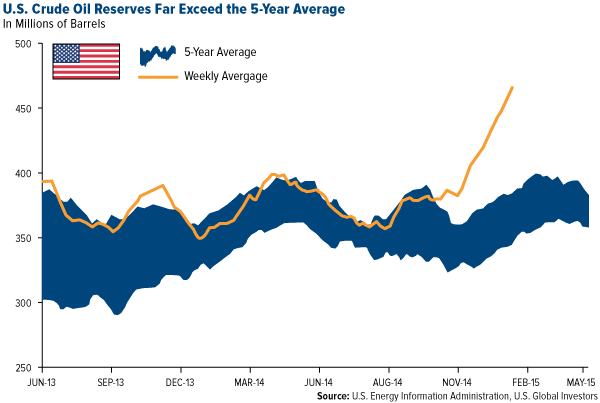
click to enlarge
This week we also learned that storage at Cushing Oklahoma reached 54.4 million barrels a new high. Cushing is important to monitor because it’s the nation’s largest storage facility and serves as the pricing point for WTI. Since it was upgraded in 2011 maximum capacity now stands at 85 million barrels.
But if the current fill rate keeps up—2.12 million barrels a week—the cap could be reached as soon as this June however unlikely that seems. Vehicle sales are up as is the number of miles being driven on U.S. highways and the busy summer travel season is fast approaching.
American Innovation to Thank
Simply put technological advances such as hydraulic fracturing or fracking have made the oil-extraction process much more efficient than anything we’ve seen before. Amazingly output continues to climb even as the number of rigs in operation has dropped for the fifteenth week.
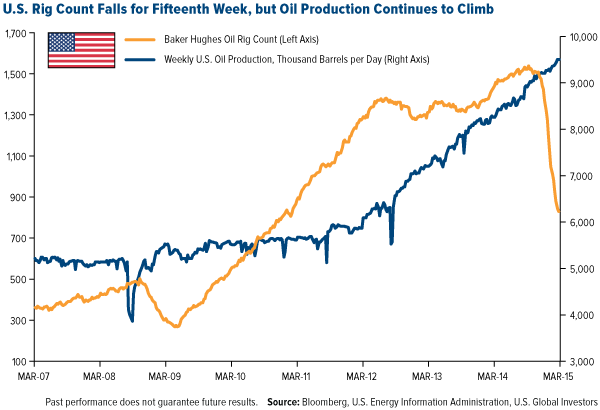
click to enlarge
“Productivity is up 50 percent over the last five years” Brian says. “There’s already been some slowdown but we’re still seeing the strong momentum from last year.”
That momentum could be enough to propel us toward 10 million barrels a day something we haven’t seen in this country since 1970.
This incredible rise in efficiency has led some analysts to foresee a possible “storage crisis” in North America. It’s possible—though again unlikely—that we’ll eventually reach a point when there just isn’t any more commercial storage space. “Crisis” is certainly a loaded word but such an event could serve as the catalyst that forces companies to make meaningful production cuts.
In the meantime energy storage and transportation companies such as and Tsakos Energy Navigation are profiting in a world of abundant oil. Tsakos recently saw strong trading after it announced a dividend and last week gave the company a “buy” rating.
Another area that’s benefited in this climate is the plastic packaging and container industry. Since oil prices began to go off the cliff last summer returns for Graphic Packaging have climbed more than 20 percent; Sealed Air 39 percent; and Berry Plastics 42 percent.
Demand Not Dissipating
At the same time that fracking has pushed daily U.S. oil output to 32-year highs improvements to our vehicles’ internal combustion engines have increased the number of miles we can drive on a tank of gas to all-time highs.
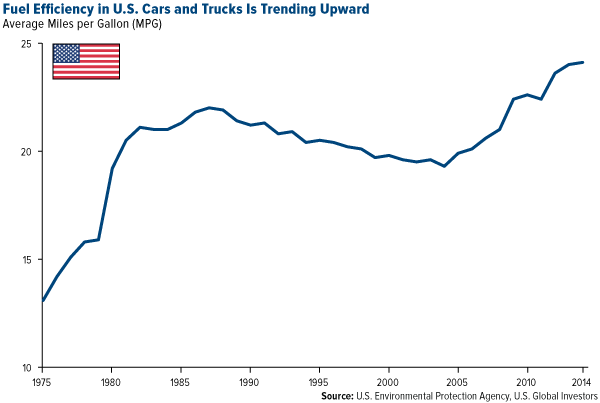
click to enlarge
Requiring less fuel to get farther doesn’t mean demand is slipping. Quite the opposite actually. Car and truck sales are expected to climb for the sixth straight year in 2015 a winning streak we haven’t seen in over 50 years.
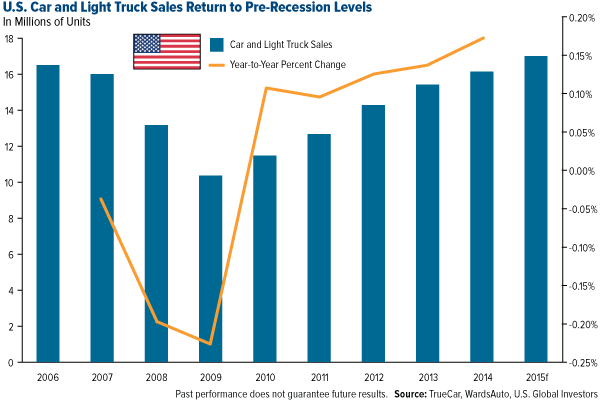
click to enlarge
Automobile pricing and information website TrueCar predicts that 17 million light-weight vehicles will be driven off car lots by the end of 2015 a 10-year high.
Since 2009—when sales plummeted to roughly 10 million units their most depressed state since 1982—year-over-year sales growth has surged as the U.S. has pulled itself out of the recession. In each of the past 12 months 200000 or more new jobs were made available to Americans the most since 1977.
Americans are not only buying more vehicles—some as new additions others to replace aging clunkers—but they’re also taking them on the road more especially now that national average fuel prices have fallen more than 31 percent from a year ago.
In fact Americans drove a record 3.05 trillion miles on U.S. highways in January for the 12-month period breaking the previous record set in November 2007. And with the busy summer travel season ahead of us we should expect to see this number rise even more.
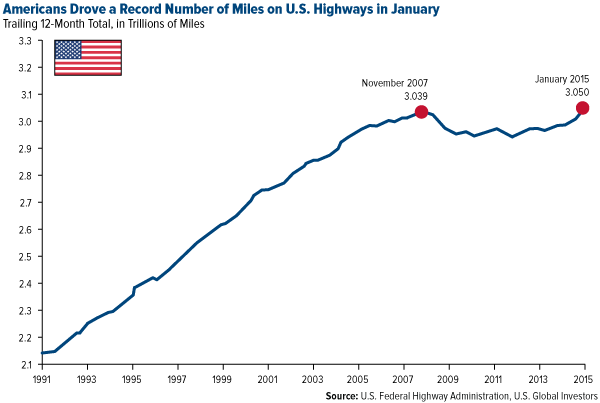
click to enlarge
Three trillion miles by the way is the equivalent of taking more than 200 round trips to Pluto.
That’s a lot of fuel being consumed—even if our vehicles are more fuel-efficient.
According to the Energy Information Administration (EIA) gas consumption in 2015 will rise 1 percent over the previous year to reach 9 million barrels a day—a little under the number of barrels of oil the U.S. now produces daily.
Add to that the fuel consumption coming from U.S. airlines which are also working on improving fuel-efficiency. As I pointed out earlier this month the number of miles flown on both domestic and international carriers is flying higher along with the number of seats per flight.
Down Under
Currently I’m in Melbourne Australia attending a conference for chief executives from all over the world. It’s inspiring and exhilarating to meet and share ideas with so many other global innovators thinkers and problem-solvers. This is ultimately what’s needed to cultivate the ideas that can lead to the sorts of life-changing advancements I discussed above.
Have a blessed weekend and happy investing!

Index Summary
- The major market indices finished lower this week. The Dow Jones Industrial Average fell 2.29 percent. The S&P 500 Stock Index fell 2.23 percent while the Nasdaq Composite fell 2.69 percent. The Russell 2000 small capitalization index fell 2.05 percent this week.
- The Hang Seng Composite gained 0.46 percent; Taiwan fell 2.52 percent this week and the KOSPI fell 0.86 percent.
- The 10-year Treasury bond yield rose 3 basis points to 1.96 percent.
 |
![[thumb]](http://www.usfunds.com/tasks/render/file/fileID=3DFA36D3-0FBE-4FF2-A3122997743CD6A4&fileEXT=.jpg) March 25 2015 Concerned about a Rate Hike Stay on the Low End of the Yield Curve | ![[thumb]](http://www.usfunds.com/tasks/render/file/fileID=FA352BF7-F090-BBFA-00263F6ED8B51F30&fileEXT=.jpg) March 24 2015 Gold’s Biggest Threat | ![[thumb]](http://www.usfunds.com/tasks/render/file/fileID=D82F0687-0E5A-0BFF-78D9F5906F29D1F4&fileEXT=.jpg) March 23 2015 What’s In Store for Gold |
 |
Domestic Equity Market
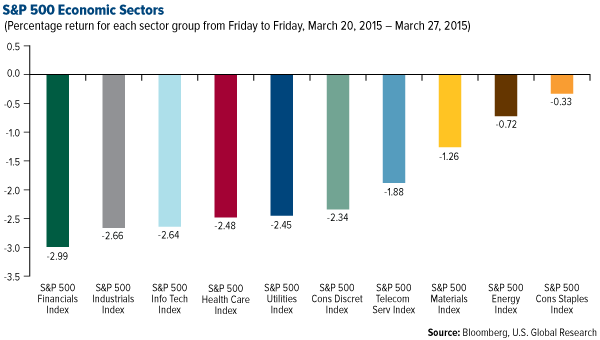
click to enlarge
Strengths
- Markit’s flash U.S. composite purchasing manager’s index (PMI) rose to 58.5 in March the best reading since September. The services sector gauge climbed to 58.6 also the best since September while the manufacturing index moved up to 55.3 its highest point since October.
- Sales of newly built single-family homes surprised the market with a third month of solid gains rising 7.8 percent to 539000 units on an annualized basis in February. Analysts had been expecting to see a decline. The brisk pace of sales contributed to inventory on the market shrinking from 5.1 to 4.7 months.
- was the best performing stock in the S&P 500 up 43.85 percent for the week on the announcement of a $46 billion merger with Heinz. It is the largest merger so far in 2015 and is being led by and Brazilian firm 3G Capital Partners. Heinz shareholders will own 51 percent of the combined firm while Kraft shareholders will hold a 49 percent stake.
Weaknesses
- The S&P 500 experienced its second-worst week this year. The financials sector was the worst performer falling 2.99 percent for the week.
- Reports showed U.S. durable goods orders declined a seasonally adjusted 1.4 percent in February. The core measure of non-defense capital goods excluding aircraft also dropped 1.4 percent. January’s orders were revised down to -0.1 percent from the previously reported 0.5 percent.
- was the worst performing stock in the S&P 500 down 25.82 percent for the week on a statement from the company that said it would record revenues of close to $1.3 billion in the current quarter down from its previous projection of $1.4 billion or more. The company also withdrew its previously released guidance for 2015.
Opportunities
- The U.S. dollar finished the week lower ahead of jobs data next week and after Chairwoman Janet Yellen reiterated on Friday that she is giving “serious consideration” to start reducing the Fed’s accommodative monetary policy. Yellen also noted that a rate hike may be warranted later this year. If the dollar continues to decline concern over companies with a high percentage of foreign sales may abate.
- With record low bond yields in the U.S. and abroad stocks with a better dividend yield continue to offer good value.
- Yellen announced on Friday that the labor market is “likely to improve further in coming months.”
Threats
- Turmoil in Yemen caused heightened volatility as tensions erupted into a regional conflict. Saudi Arabia and its allies bombed Shiite rebels allied with Iran and Egyptian officials said a ground assault will follow the airstrikes. Iran denounced the Saudi-led air campaign calling it "a dangerous step."
- The Citi Economic Surprise Index which measures economic data surprises relative to consensus expectations remained at new multi-year lows. This does not bode well and could point to further negative economic surprises.
- The University of Michigan Consumer Sentiment Index had a final reading of 93 above forecasts but below the final February reading of 95.4. As a leading indicator further dips could signal underlying weakness in the economy.
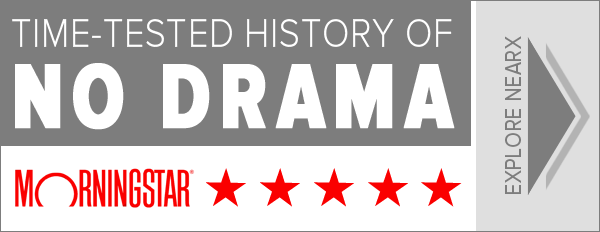
The Economy and Bond Market
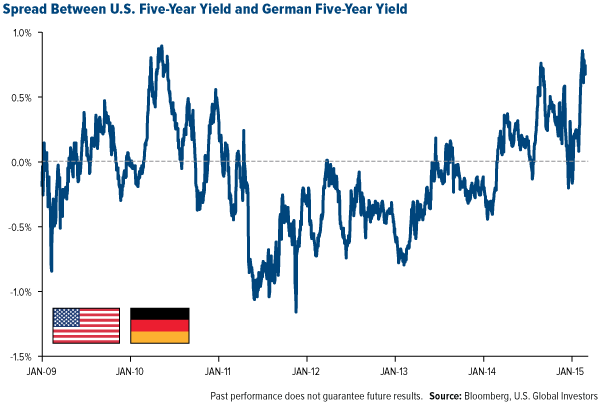
click to enlarge
Strengths
- German inflation expectations have risen stantially since the start of the European Central Bank’s (ECB’s) bond purchasing program. The German five-year breakeven inflation rate reached its highest point since May 2014. Furthermore business climate expectations are on the rise as the IFO Business Climate Index exceeded analyst expectations.
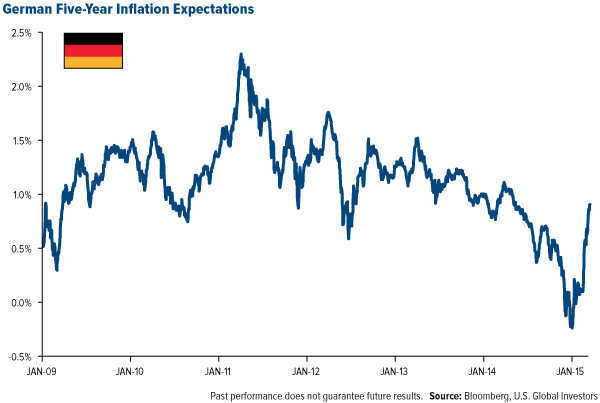
click to enlarge
- The University of Michigan Consumer Sentiment Index remains highly elevated in the United States. Consumers are feeling their purchasing power rise as energy prices remain depressed and the U.S. dollar remains strong.
- The dollar retreated for the second week in a row this week. The recent stance from the which came across more dovish than many expected is the primary culprit for the pull-back in the currency.
Weaknesses
- China’s manufacturing purchasing managers index (PMI) fell below 50 this week to 49.2. While the reading may be viewed as bullish to the extent that it causes further stimulus from China it still signals a slowdown in this economic powerhouse.
- U.S. equities retreated this week giving back nearly all the gains we saw during the previous week. The S&P 500 Index fell 2.24 percent this week.
- German stocks finally retreated this week after a 10-week streak of consecutive positive gains. The Deutsche Boerse AG German Stock Index fell 1.42 percent this week. The German index has hit 26 record-closing highs this year according to FactSet.
Opportunities
- The Eurozone’s manufacturing services and composite purchasing managers indices (PMIs) all exceeded economists’ expectations this week. It’s become clear that the European economies have the right momentum behind them following the official start of the ECB’s bond purchasing program.
- Geopolitical tensions within Eastern Europe remain muted for the time being. Furthermore any de-escalation in the region remains a positive.
- The ’s dovish tone in last week’s meeting is long overdue according to some. It appears that if interest rates do rise this year it will be later and at a slower pace than expected.
Threats
- Portuguese Spanish Italian and Irish yields on 10-year government bonds are all lower than U.S. 10-year Treasuries. Highly irregular and without much fundamental support this price distortion could fuel asset-price bubbles in Europe.
- Despite the dovish tone from the Fed there is still a possibility that they may raise rates too soon undermining the recovery and erasing the gains seen through the first rounds of quantitative easing (QE).
- The U.S. dollar remains as the spotlight currency. While the dollar’s rise has sided for the time being it shows no clear sign of a reversal as of yet.
 |
![[thumb]](http://www.usfunds.com/tasks/render/file/fileID=670097A7-F601-D0A4-72C639D36767ADCE&fileEXT=.jpg) March 26 2015 A Tale of Two Economies: Singapore and Cuba | ![[thumb]](http://www.usfunds.com/tasks/render/file/fileID=D6AA5D4E-EC66-B453-C5448958286AB8E1&fileEXT=.jpg) March 23 2015 Why This Airline Just Landed in the S&P 500 Index | ![[thumb]](http://www.usfunds.com/tasks/render/file/fileID=0912BEA7-BC6E-9F92-E5E143C97C59B422&fileEXT=.jpg) March 19 2015 What the and the Fear Trade Do for Gold |
 |
Gold Market
For the week spot gold closed at $1198.75 up $16.12 per ounce or 1.36 percent. Gold stocks as measured by the NYSE Arca Gold Miners Index lost 1.82 percent. The U.S. Trade-Weighted Dollar Index slipped 0.53 percent for the week.
| Date | Event | Survey | Actual | Prior |
| Mar-23 | HSBC China Manufacturing PMI | 50.5 | 49.2 | 50.7 |
| Mar-24 | U.S. YoY | -0.10% | 0.00% | -0.10% |
| Mar-24 | U.S. New Home Sales | 464K | 539K | 481K |
| Mar-25 | U.S. Durable Goods Orders | 0.20% | -1.40% | 2.80% |
| Mar-26 | Hong Kong Exports YoY | 3.00% | 7.20% | 2.80% |
| Mar-26 | U.S. Intial Jobless Claims | 290K | 282K | 291K |
| Mar-27 | U.S. GDP Annualized QoQ | 2.40% | 2.20% | 2.20% |
| Mar-30 | German YoY | 0.30% | - | 0.10% |
| Mar-31 | Europe Core YoY | 0.70% | - | 0.70% |
| Mar-31 | U.S. Consumer Confidence Index | 96.5 | - | 96.4 |
| Mar-31 | HSBC China Manufacturing PMI | 49.3 | - | 49.2 |
| Apr-1 | U.S. ADP Employment Change | 224K | - | 212K |
| Apr-1 | U.S. ISM Manufacturing | 52.5 | - | 52.9 |
| Apr-2 | U.S. Initial Jobless Claims | 285K | - | 282K |
| Apr-3 | U.S. Change in Nonfarm Payrolls | 250K | - | 295K |
Strengths
- said that after seven consecutive days of gains in the gold market it has become increasingly difficult to dismiss the rally as merely a function of the recent weakness in the U.S. dollar. Additionally Saudi Arabia-led bombings in Yemen this week boosted demand for safe-haven assets. The Saudi government pledged to continue the strikes against Shiite rebels to prop up the allied government.
- believes the euro/dollar squeeze is not over meaning the dollar should continue to correct lower. Given this outlook BofA recommended buying any dips in the gold price and set a target of $1307 per ounce.
- Shanghai Gold Exchange withdrawal volume through March 13 was 51.5 metric tons (mt). If this pace continues withdrawals this year would exceed last year’s 2102 mt.
Weaknesses
- JPMorgan Chase HSBC SocGen and will be the participant banks in setting the LBMA Gold Price benchmark. Several of these banks have been involved in commodities price-fixing scandals. China now a major player in the global gold trade was not granted representation. Commentators have speculated that had Chinese banks been included there would be less room for manipulation.
- Reports have been circulated speculating that Nevsun’s Bisha mine had been bombed by the Ethiopian Air Force in retaliation for an Ethiopian helicopter being held by Eritrea earlier in the week. So far Nevsun has only reported an “act of vandalism” at the mine which caused no significant damage affecting only the base of a tailings thickener.
- non-commercial Nymex shorts have more than doubled since the beginning of February and last week rose another 13.2 percent to their fourth successive all-time high. Several factors have weighed on the metal recently including an ongoing weak demand outlook due to constrained diesel auto catalyst consumption in Europe poor jewelry demand for in China and South African supply recovering much more quickly than expected after last year’s five-month-long strikes.
Opportunities
- HSBC analysts some of the earliest adopters of a bullish view on the U.S. dollar back in 2013 now believe the dollar rally may be at or nearing its end. The analysts point out that past dollar rallies of this type have mostly seen a dollar appreciation of around 20 percent and lasted from under a year meaning the current rally is already extended. Furthermore they pointed out that disappointing U.S. economic data is mounting and being largely ignored. Valuations suggest that the U.S. dollar may now be the world’s most overvalued currency only being overshadowed by the strength in the Swiss franc since its tie to the euro was cut.
- The Philadelphia Gold and Silver Index made up of the largest gold stocks is at around a 73 percent discount to the bullion price with the index more than 60 percent lower than the start of 2008. Gold on the other hand is still more than 40 percent higher. The index’s total price/cash flow has almost halved from 2008 to around 7.5x from 14.3x even though it is expected to post its first positive operating income this year since 2012.
- TD Securities published a precious metals outlook in which the firm questions the sustainability of the supply/demand balance in the gold market due to declining reserves. 2014 marked the third straight year of reserve declines with exploration spending being reduced as miners focused on capital preservation. Total reserves for the large-cap producers are down around 24 percent from the 2011 peak. The decline highlights that existing exploration budgets are not sufficient to keep pace with current mining depletion. In contrast announced it recently intersected 14.8 grams per tonne (g/t) gold over 10 meters and 11.5 g/t gold over 8 meters in a step-out drilling up to 330 meters from triangle. Discoveries like Integra could make it of interest as a takeover target.
Threats
- Analysts at SocGen published a report in which they forecast that the gold price having given away all its early year gains is headed sharply lower as they see a continuation in the dollar’s strength. They see the price of gold falling to an average of $925 per ounce between 2016 and 2019. The timing of the report was perhaps unfortunate in that it predated the events of the past few days which has seen the reverse occur.
- CPM Group sees gold falling for a third straight year in 2015 as concern eases that global economies will falter curbing demand for the metal as a haven. CPM Group forecast gold will average $1208 per ounce in 2015.
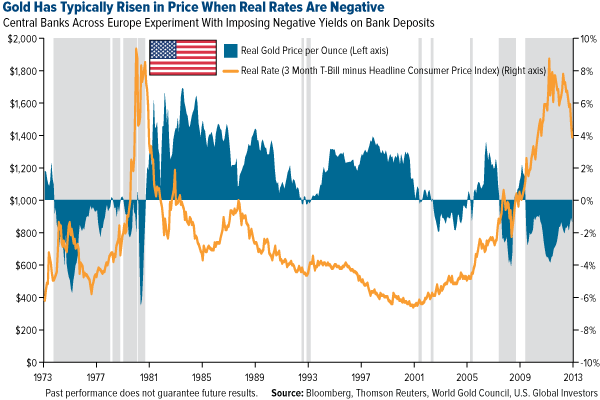
click to enlarge
- Under the auspices of fighting terrorism France’s Minister of Finance has rolled out a series of eight new restrictions aimed specifically at minimizing the use of cash. In reality these are capital controls designed to keep individuals’ savings trapped in the banking system. Many banks in Europe have already dropped their deposit rates into negative territory and as interest rates become even more negative more people will realize that they’re better off holding physical cash instead of paying their banker to hold it for them.

Energy and Natural Resources Market
Legal Disclaimer:
MENAFN provides the information “as is” without warranty of any kind. We do not accept any responsibility or liability for the accuracy, content, images, videos, licenses, completeness, legality, or reliability of the information contained in this article. If you have any complaints or copyright issues related to this article, kindly contact the provider above.